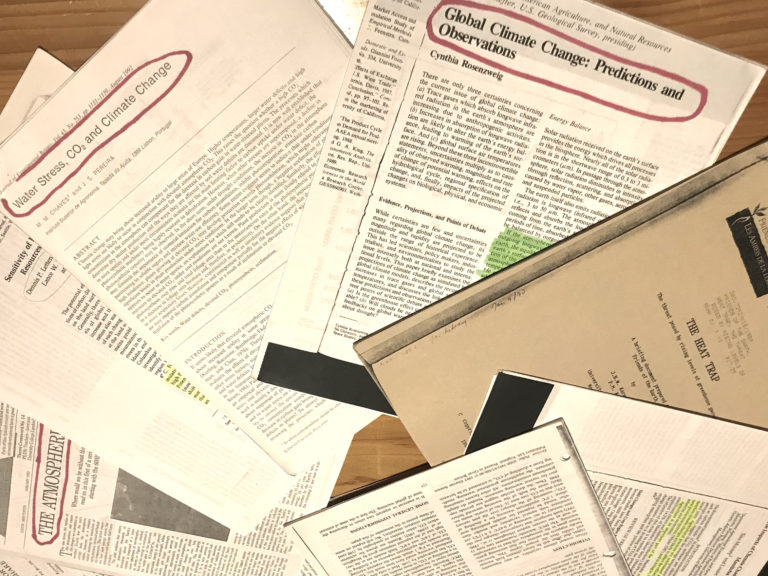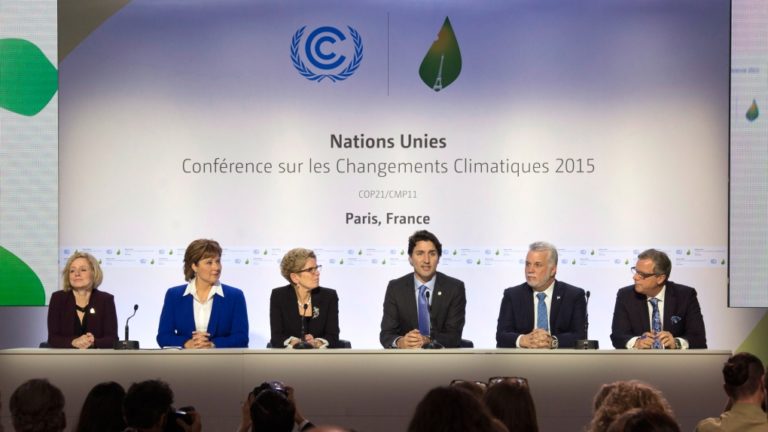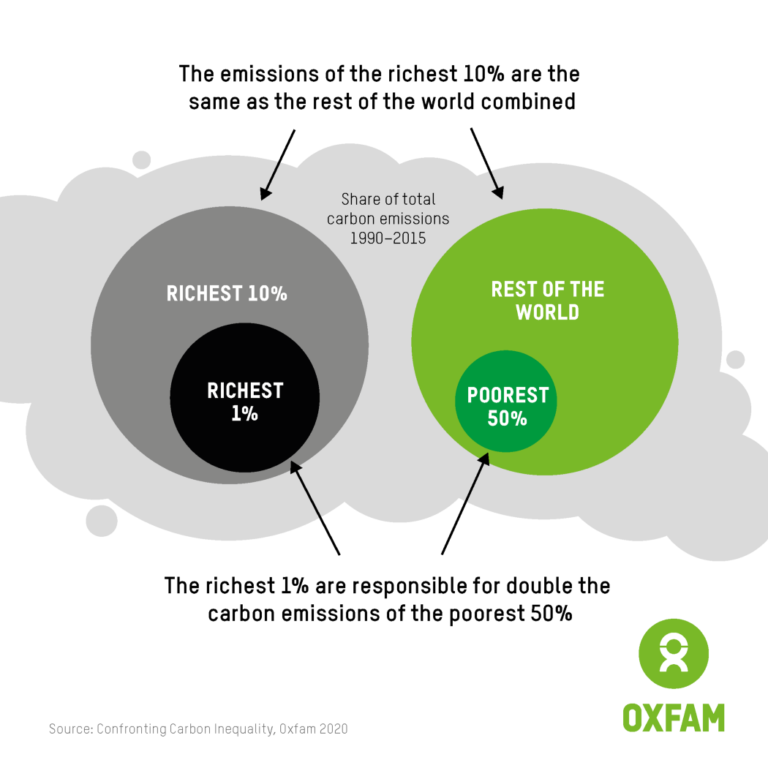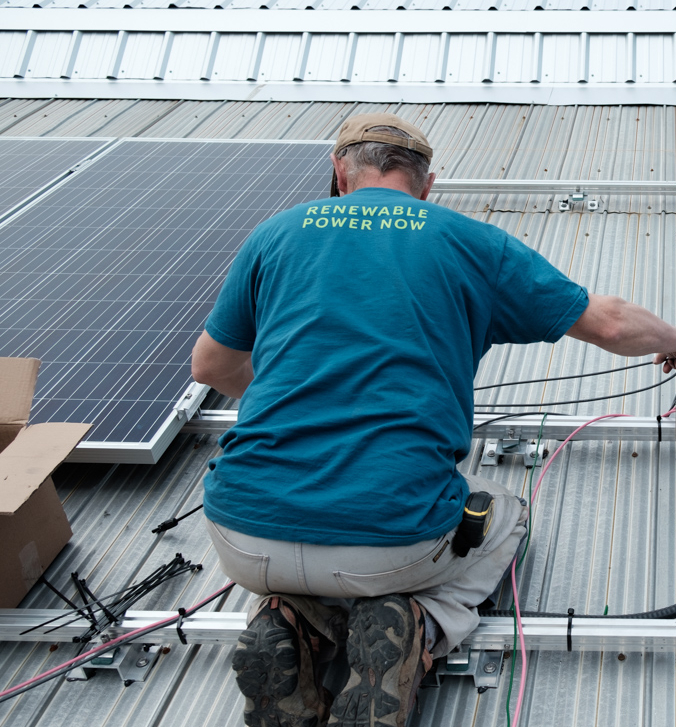Plan B: Decarbonize
We can’t wait for our leaders to save us. We have to get off fossil fuels.
The year was 1994. I was finishing a Bachelor’s of Science degree and chose climate change for my final paper in fourth-year physical geography. I don’t recall the grade I got, but what I learned solidified my determination to work on environmental problems.
When I packed up at the end of university, for some reason I stashed photocopies of the reference journals I used into a big envelope and tossed that envelope into a box containing photos, newspaper clippings and other memorabilia from my years at the University of Victoria.
Fast forward to 2020 and I’m down in the crawl space digging around for winter coats. I tip over that old box and out spills those papers. I had entirely forgotten them. Reading one after the other was like traveling back to a time where all options were on the table. We had all the information and most of the tools needed to solve the climate crisis. A quarter-century later that clock has run out.
We’re facing two choices. Rapid decarbonization now, or flying the plane straight into the side of the mountain. My view is working towards decarbonizing your life and your community should be elevated as high up your priority list as you can manage with the resources you have.
For me, taking a trip back through those notes crystalized my thinking. With precious time remaining it’s time for Plan B: a community-driven push to free ourselves from fossil fuels, and reclaim literal power at the local level. Otherwise we’re stuck waiting for politicians.

The view from the nineties
While I was studying at UVic, a wave of new scientific research was published in response to the first Intergovernmental Panel on Climate Change report, released in 1990. Climate change was a controversial topic, but the threat was taken seriously by politicians of the day. Building on the successful policy interventions that eliminated ozone-destroying Chlorofluorocarbons, all eyes looked to the Kyoto 1997 UN climate conference for a fix on climate.
Even though a few outlier countries spurned the accord, enough consensus was reached that it was time to act. By the time the Kyoto Protocol was signed in 1997, a road map had been created. Options were on the table – forest conservation could be paired with a transition off oil and gas. As the century drew to a close, environmental wins were piling up. The extinction of the great whales and acid rain had been halted. Up next? Putting the screws to global warming.
The optimism of science
Policymakers at think tanks and global environmental organizations weren’t alone in their optimism.
Perhaps the biggest shock from revisiting those 30-year-old models is that their worst-case scenarios (the ones that triggered condescension and disdain from skeptics) are today’s best-case scenarios. Not a single paper overestimated where our temperatures and greenhouse gas emissions would be a quarter-century later. Though their predictions and trajectories were prescient, scientists didn’t have enough data from feedback loops. So they underestimated the rate of change.
More importantly, they didn’t factor in the backlash from industry, or the collective paralysis it would create. They thought the same governments funding their research papers, and the same international frameworks validating their data, would apply what science was telling them – and limit emissions. So, many papers assumed a robust collective response – for example, emissions leveling off in the early 2000s and declining by 2010.
They weren’t wrong to do so – the forests and lakes of the Northeast were coming back as politicians on both sides of the 49th parallel came together to tackle acid rain. People like me working in ‘the field’ left the ‘climate problem’ to the ‘climate folks’ to sort out. The analogy was there. Solving it alongside other major environmental problems was Plan A.
The solutions at hand
In 1995 one of the world’s first hydrogen fuel cell vehicles “rolled off the assembly line” at UVic. Well, that’s not quite true. Fourth-year engineering students converted a Ford Taurus with cells donated by Burnaby’s Ballard Power Systems. A few years later, with much fanfare, the BC NDP announced the world’s first hydrogen transit bus, which did the rounds in Vancouver.
My good friend Steve’s engineering papers were mixed in with my climate ones in that old box I found in my basement. Steve, who went on to work for Ballard, was confident all of us would be driving fuel cell-powered vehicles within a decade. The optimism of industry in that period was palpable. Taking a “problem identified → solution forthcoming” approach, the feeling was that GM’s EV1 and other mid-90’s electric car prototypes with 300-km range were either out on the street or about to be.
Meanwhile, conservation efforts like Yellowstone to Yukon and the Rio Summit garnered public support. However, a movement towards sanity spanning political, industrial, and scientific communities turned out to be relatively short-lived. Nobody was prepared for the well-orchestrated fight-back collectively organized by the oil and gas industry. The next thing we knew the electric cars were recalled and crushed, and well-funded astroturf groups grew like fracking sites on a satellite map.
The reality of government

As campaigns to deprioritize and discredit science gained traction, the science community’s only recourse was to shout their now-ignored recommendations louder. It didn’t work. Canadians looking to their politicians for leadership instead heard talking points drafted by Big Oil.
In 2002, senior Chrétien cabinet minister Anne McClelland stated: “We must ensure there is nothing, as we move forward to implement Kyoto, that in any way would undermine or impede the growth of projects like the oil sands.” In 2011, as senior Harper cabinet minister Peter Kent pulled Canada out of the accord, he said simply: “Withdrawing allows us to continue to create jobs and growth.” And of course who can forget the words of our current Prime Minister, who remarked in 2017 that “no country would find 173 billion barrels of oil in the ground and just leave them there.”
Time for Plan B
The reality remains, as it has for decades, that not a single elected MLA or MP in this country has the power to fix the climate crisis, even if they had the qualifications, desire, or aptitude. The proof is in our emissions of CO2(e). They are still increasing, despite the constant talk from politicians about ‘climate action.’ It’s time we stopped waiting for them, and started acting ourselves.
We’ve engineered entire trading systems and national economies to support the extraction and sale of oil and gas. As soon as you can, commit to stop using them. We’ve allowed giant utilities controlled by people with ridiculous salaries to hold a monopoly on energy. If you have the means and an alternative – disconnect.
We’ve become paralyzed by the consequences of acting out of turn (otherwise known as leadership): What if those with their hands on the levers of the global economy find some way to keep the promise of industrial prosperity on the horizon? What if that ship sails without us?? Weigh anchor and defend the things that make us British Columbians – they hold more value in the long term.
When enough of us back our words with action, we arm ourselves with the moral authority to win our first big fight. The wealthiest 10 per cent on our teetering planet emit over half of the world’s carbon. My guess is the other 90 per cent of us will support increasingly aggressive taxation if it shifts the costs of pollution onto the backs of the wealthiest, and funds good things for the rest of us.

Controlling what we can
For too long our attitude has focused on the conduct of big oil companies, while forgetting our consumption is what allows them to grow. We compare our country’s pollution to enormous levels in the U.S. and China while ignoring Canada’s shocking per-capita numbers. And we’ve bought into a manufactured mythology around oil and gas industry jobs, which are dwindling anyway even as production grows.
Fortunately, many of the tools we need to flip the trajectory can be found in the decisions we make at home. Working at a small scale allows us to imagine larger change. As we start to decarbonize and a handful of people join us, we create ripples across the pond. By the time it reaches the shore, thousands more are in. And the benefits start to compound: Cleaner air in places where the poorest citizens live, safer schools, more control over the energy trade, better local jobs – the impacts down the line will be exponential, even revolutionary. The tipping point is closer than you might think.
Viewing your decisions through the lens of local power
There is no one-size-fits-all solution to this crisis. However, no matter who you are, and where you live, if you use the lens of local power to help guide your next steps, achieving what seems improbable (dismantling the fossil fuel economy and radically lowering our collective emissions) becomes possible.
Switching to a bus pass or EV or e-bike or a heat pump instantly reduces pipeline, utility, and distribution company profitability. They still have to extend their infrastructure just as many kilometres, but are suddenly missing the critical mass of customers willing to pay the prices they need to finance that expansion.
And, decarbonizing influences the people around you. Take Dave from BC Hydro. Are your neighbours going to listen to a TV ad and swap out their lightbulbs? Or are they going to look at you, and the fact that you don’t even have an electrical or gas bill? We’re creating cultural touchstones that will outcompete the status quo.
It only takes a noticeable percentage abandoning the fuel burning appliance market for things like gas furnaces and diesel trucks to become stranded assets. Take SUVs. Piles of new ones hit the market each day because owners expect they’ll be able to shuffle off their old ones every four years and trade up. But current trends tell us in four years at least one quarter of new and used buyers won’t be interested in gasoline engines at all. When supply exceeds demand, value collapses. It’s now a question: what premium will you pay to insure or sell a gas powered home past 2030?
Extending that lens to your community
If a quarter of drivers are buying EVs, is it so hard to imagine one quarter of the households in Courtenay or Duncan or Kamloops generating their own rooftop power? I mean for starters, they will have a giant battery on wheels in their driveway that charges from, and could even generate power for, the house.

A forward-thinking city council would add panels to the shopping malls, municipal buildings, and schools. All of a sudden your town is insulating itself from rising carbon taxes and the future cost of the Site C dam. Other residents are going to want in. Five municipalities in B.C. already have their own utilities, and that list will grow as residents demand an alternative to Fortis and BC Hydro.
All of a sudden that decision you made to decarbonize is kicking off a very interesting structural democratic shift. Where your community, not the province, has the power. What did Margaret Mead say about a small group of thoughtful, committed citizens?
The opportunity of decarbonization
Changing your focus from a general concern about the climate crisis ‘out there’ to a decision to decarbonize starts a chain reaction.
At the end of that chain are workers with jobs closer to home, in industries with a future.
At the end of that chain are children who don’t have to start their life breathing emissions from diesel trucks or the refinery purposefully placed in their neighbourhood.
At the end of that chain, rich people will be taxed every time they move, or if they decide to heat monster homes with fossil fuels, providing revenue to redistribute in society.
We’ll never regain the options we had in the 90s to solve the climate crisis. However with a sharper focus, we can regain some hope, and create the best world possible, by making decisions over things we can control in our communities, where they count.


I couldn’t agree with you more. The oil and gas giants will never lead the charge away from the absurd cash flow they get leaving the industry status quo. It IS up to us. Every home in Canada needs it’s own power generating turbine that creates enough power for all the household needs. No more need for dams, Fortis or BC Hydro. Geothermal heating for the areas in Canada where that would be applicable. The real change will happen when we the consumers no longer need their services. Respect to you for fighting this battle. Your an angel we need more people like you.
Where are the 5 municipalities in
BC that have their own utilities?
Good sources for info on heat pumps and the best EV’s, please!
Hello Kathleen – the five municipal utilities are: City of Nelson, City of New Westminster, City of Grand Forks, City of Penticton, and the District of Summerland. We’ve got some information on Heat Pumps for you. Check out our Decarbonize BC webinar series https://hub.dogwoodbc.ca/decarbonizebc_webinars and scroll down to Episode 4: Creating Your Home Retrofit Road Map. And the best EV for you is likely out there or arriving shortly. Check-in with your local EV-owners club online.